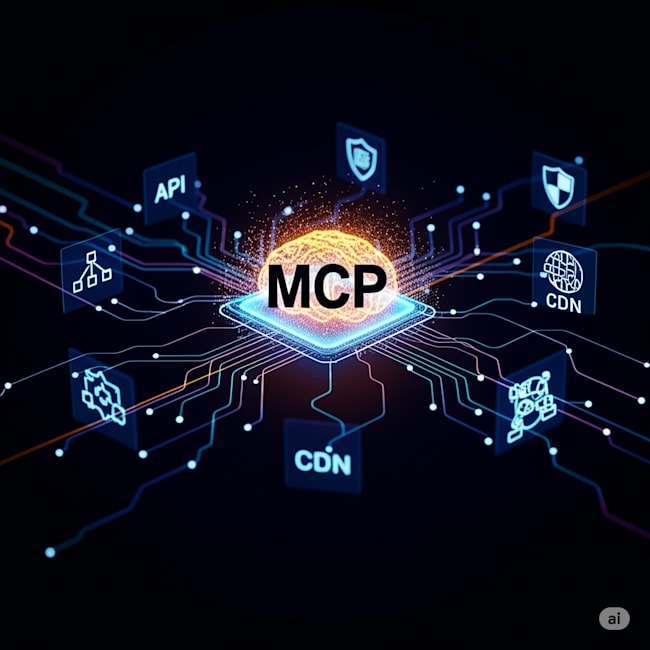AI's New Language - How MCPs will Reshape Tech 🤖
And why your API, CDN, and security strategies need to catch up—fast.
I am experimenting this blog post in the style of Axios article. Hope you’ll like it and do let me know your feedback!

🧠 1 big thing: The AI-native future is being built on a new protocol.
- Background: Model Context Protocol (MCP) - a new protocol is laying the foundation for how AI models will interact with the digital world.
Think of MCP like a USB-C port for AI applications. Just as USB-C provides a standardized way to connect your devices to various peripherals and accessories, MCP provides a standardized way to connect AI models to different data sources and tools. (Source)
- Why it matters?: For CDNs, Security organizations and API vendors, this is a fundamental shift that creates a massive opportunities for newer services, higher profits and deeper integration into the AI ecosystem. As traffic reduces to traditional websites, traffic generated by agents can augment or substitute the revenue. But, it also introduces a new frontier of risk.
🗺️ The big picture: Beyond the chatbot
-
The context: Current AI systems are powerful but siloed. To perform real-world tasks, it needs access to secure and reliable access to external data and functions - from checking current weather to deploying a software patch.
-
The solution: MCP standardizes this communication. Instead of building one-off integrations for every AI model and every tool, MCP creates a common language. This makes connecting AI to your business not just possible, but scalable.
-
Zoom in: At its core, MCP is an “API of APIs” - a wrapper that gives AI models a predictable way to call upon any service you want to expose.
💡 The opportunity: 3 ways to win in the MCP era
Here’s my vision on how experts in 3 key tech sectors can capitalize on the shift.
1️⃣ APIs: The foundation of value
-
The bottom line: At its core, MCPs are API wrappers. Any optimization that makes API faster, more reliable, or more efficient directly translates to a better MCP integration.
-
Go deeper:
- Low-hanging fruit: Well-documented, secure and high-performance APIs will be the firs to be “MCP-enabled”.
- The opportunity: Companies that specialize in API-management, gateways and developer tooling are perfectly positioned to offer “MCP-readiness” services.
- Case-point: You can now convert your Postman collection to MCPs!
2️⃣ CDNs: The profit engine 💰
-
The bottom line: CDNs already do more than just cache cat images. With edge computing, they can become intelligent gatekeepers for MCP requests, creating new revenue streams through “service arbitrage”.
-
Go deeper:
- How it works: An MCP request hits the CDN edge. Based on rules you set - like a user’s subscription tier, the CDN routes the request.
- Premium user? 👑 Route to a powerful, expensive AI model
- Free user? 🎟️ Route to a cheaper, faster, or more basic model.
- Fastly has already introduced semantic caching that can further improve caching and end-user performance.
- The result: This increases margins for the service operator while still ensuring a good user experience for everyone. It’s a win-win powered by the edge.
- How it works: An MCP request hits the CDN edge. Based on rules you set - like a user’s subscription tier, the CDN routes the request.
Security: The essential guardian 🐘
-
The bottom line: Connecting AI directly to your core services is powerful but risky. Opening up this new door means a much larger surface area for cyberattacks.
-
Go deeper:
- The threats are familiar: The same security challenges that plague APIs today will be amplified with MCPs. Think:
- 🕵️♂️ Man-in-the-middle attacks: Intercepting requests between the AI and your service.
- 🎭 Session replays: Reusing old authentication tokens to gain unauthorized access.
- ☠️ Cache poisoning: Tricking the system into service malicious data.
- The role for security firms: This is a massive opportunity for cybersecurity companies to step in with solutions for MCP threat detection, anomaly analysis, and robust access control. A good starting point would be to use the OWASP’s API Security Top 10 and build robust defense against malicious use.
- The threats are familiar: The same security challenges that plague APIs today will be amplified with MCPs. Think:
🔮 What’s next: The race to adapt
The adoption of MCP is still in early stages, but the momentum from major AI players is a clear signal of where the industry is heading.
- For businesses: Start planning your MCP strategy now. Audit your existing APIs, evaluate your CDN’s edge capabilities and pressure-test your security posture.
- For investors: Keep an eye on the companies buildings the picks and shovels for this new gold rush - the API gateways, edge platforms, and cybersecurity firms that will enable this next way of AI integration.
The future of AI isn’t about smarter models; it’s about connecting them securely and profitably to the real world. MCP is the bridge to that future.
👀 Extra: Other Industries to watch out
MCP relies on 3 services - data, documents and services (which we covered). Companies in these fields will see a flurry of launches to support MCP.
- Database/data warehouse/data lakehouses will soon offer MCP connectors to extract organizational data.
- Document & cloud storages will be integrated to MCP or through a RAG solution for extracting relevant information to feed to an MCP pipeline.
